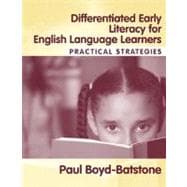
| Differentiated Early literacy for English Language Learners | |
| Introduction | |
| English Language Learners and Standards | |
| Tips for increasing parental involvement | |
| Strategies and activities that fit | |
| How to use this book | |
| TESOL Goals & Standards | |
| Identifying Proficiency Levels | |
| Matching Instructional Strategies and Student Activities | |
| Quick Assessment of ELD Levels of Proficiency | |
| Detailing each level of proficiency | |
| ELD behavioral indicators across Reading/Language Arts Domains | |
| Reference Guide for Teacher Strategies and Student Activities | |
| TESOL Summative Assessment Tool | |
| Sample English Learner Profile | |
| Strategies to develop listening and speaking | |
| TESOL goals and standards | |
| Teacher Talk | |
| Total Physical Response: Instructional techniques and management strategies | |
| Grouping students according to language level | |
| Using Humor and Word Play to Facilitate Social Interaction | |
| Matching questions and responses to levels of proficiency | |
| Teaching the Mechanics of Handwriting, Grammar and Spelling | |
| TESOL goals and standards | |
| Language mechanics across levels of proficiency | |
| Handwriting | |
| Letters sorted by shape and case | |
| Use of total physical response with handwriting | |
| Grammar | |
| The world's shortest sentences | |
| Color code parts of speech | |
| Teaching prepositional phrases | |
| Spelling | |
| Stages of developmental spelling and English language development | |
| Activities to address spelling | |
| Vocabulary Development | |
| TESOL goals and standards | |
| Understanding Vocabulary Development from an English Language Learner's Perspective | |
| A Range of Strategies for Making Vocabulary and Concepts Comprehensible | |
| Strategies for Vocabulary Development across Levels of proficiency | |
| How can a real object or experience be used to teach the word? | |
| How can a visual, or model, be used to teach the word? | |
| Is the word conceptual or abstract? Use unpacking strategies | |
| Spanish Cognates | |
| Primary language support | |
| Use similes and metaphorical thinking with word study charts | |
| Developing Fluency | |
| Interactive Games to Develop Fluency with New Vocabulary | |
| Developing Descriptive Vocabulary | |
| Getting started with Inspiration software | |
| Supporting Reading Instruction | |
| TESOL goals and standards | |
| Reading in the long run | |
| Warming up | |
| Responding to reading | |
| Strength training/word power | |
| Web-based resources | |
| Speed and Pacing/Fluency | |
| Visualizing/imagining | |
| Shared read aloud activities | |
| Developing a love for the task | |
| Reading Interest Inventory | |
| Rating quality books | |
| Training logs | |
| Charting classroom reading | |
| Getting started with PowerPoint | |
| Teaching Writing Across Proficiency Levels | |
| TESOL goals and standards | |
| All children are writers | |
| The Writing Process | |
| Writing Activities Across Levels of Proficiency | |
| Interactive Writing Activities for Beginners | |
| Managing Journal Writing | |
| Individual Writing Activities for Beginners | |
| Collaborative Writing Activities for Early Intermediate and Intermediate Levels | |
| Interactive Writing Activities for Early Intermediate and Intermediate Levels | |
| Individual Writing Activities for Early Intermediate and Intermediate Levels | |
| Collaborative Writing Activities for Early Advanced and Advanced Levels | |
| Interactive Writing Activities for Early Advanced and Advanced Levels | |
| Individual Writing Activities for Early Advanced and Advanced Levels | |
| Writing Assessment Across Levels of Proficiency | |
| Writing Assessment Tools Appropriate for Beginning English Learners | |
| Writing Assessment Tools Appropriate for Early Intermediate & Intermediate English Learners | |
| Writing Assessment Tools Appropriate for Early Advanced & Advanced English Learners | |
| Table of Contents provided by Publisher. All Rights Reserved. |
The New copy of this book will include any supplemental materials advertised. Please check the title of the book to determine if it should include any access cards, study guides, lab manuals, CDs, etc.
The Used, Rental and eBook copies of this book are not guaranteed to include any supplemental materials. Typically, only the book itself is included. This is true even if the title states it includes any access cards, study guides, lab manuals, CDs, etc.